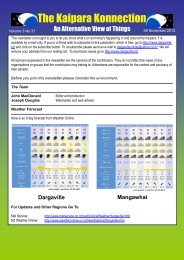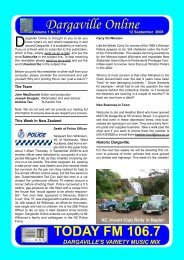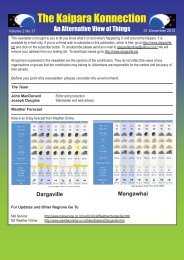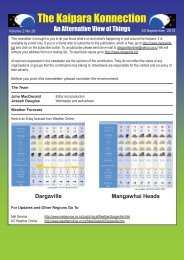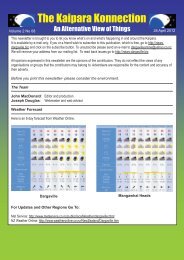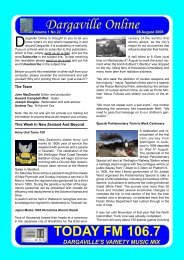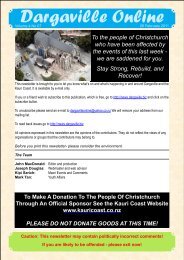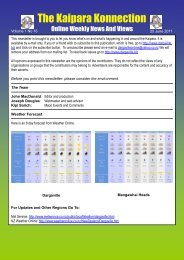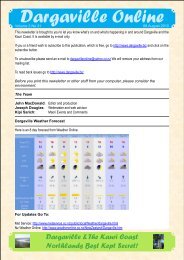8th - Kaipara Konnection - Dargaville.BIZ
8th - Kaipara Konnection - Dargaville.BIZ
8th - Kaipara Konnection - Dargaville.BIZ
You also want an ePaper? Increase the reach of your titles
YUMPU automatically turns print PDFs into web optimized ePapers that Google loves.
“Do not fear to be eccentric in opinion, for every opinion<br />
now accepted was once eccentric.” -- Bertrand Russell<br />
Some New Zealand History For The Week History 9 - 15 December<br />
11 December 1931 Statute of Westminster passed<br />
The British Parliament passed the Statute of Westminster, granting complete autonomy to its six Dominions. Australia<br />
and New Zealand held back from adopting this status, but in 1947 New Zealand became the last of the Dominions to do<br />
so.<br />
Although this country had moved from being a colony to a Dominion in 1907, few New Zealanders then wanted greater<br />
independence from Britain. Racial affinity, language, culture, defence and trade links bound most New Zealanders to the<br />
wider ‘Britannic world’, which was then at the height of its prestige.<br />
Those feelings persisted through the first half of the 20th century, even though dominion status evolved as a label for the<br />
constitutional position of the former self-governing colonies (and the Irish Free State). In 1926, after pressure from the<br />
Irish, South Africans and Canadians, the Balfour Declaration stated that Britain and the Dominions:<br />
are autonomous Communities within the British Empire, equal in status, in no way subordinate one to another in any<br />
aspect of their domestic or external affairs, though united by a common allegiance to the<br />
Crown, and freely associated as members of the British Commonwealth of Nations.<br />
New Zealand’s Prime Minister, Gordon Coates, called this a ‘poisonous document’. Although<br />
the British Parliament subsequently passed the Statute of Westminster, which formally<br />
removed London’s right to legislate for the dominions unless they asked it to do so, New<br />
Zealand refused to ratify it until 25 November 1947. The Constitution Act 1986 finally<br />
removed the last faint provision for the British Parliament to make laws for New Zealand.<br />
12 December 769 De Surville first sights NZ near Hokianga<br />
As James Cook rounded the northern tip of the North Island from east to west, the French<br />
explorer Jean François Marie de Surville was in the same waters, sailing in the opposite<br />
direction. A storm prevented any chance of an historic meeting.<br />
Image: satellite view of the northern tip of New Zealand.<br />
13 December 1642 First recorded European sighting of New Zealand<br />
Towards noon the Dutch explorer Abel Tasman sighted ‘a large land, uplifted high’. As his vessel was off Punakaiki, this<br />
may have been the peaks of the Paparoa Range.<br />
Tasman sailed from Batavia (today’s Jakarta) in the Dutch East Indies (Indonesia) in August 1642. His expedition had<br />
two aims: to establish whether there was a southern sea route to Chile which could be used to prey on Spanish ships;<br />
and to exploit the resources of the ‘great southern continent’ which many firmly believed existed between Australia and<br />
Cape Horn. The Dutch had already charted Australia’s northern and western coasts, and part of its southern coast. But<br />
how far this land extended to the east was still unknown.<br />
Tasman commanded 110 men on two ships, the Heemskerck and the Zeehaen. He discovered Tasmania (as it would<br />
later be called) on 24 November, naming it Van Diemen’s Land after the governor-general of the Dutch East Indies. He<br />
then continued east across the sea which now bears his name.<br />
New AsiAN RestAuRANt<br />
RestAuRANt<br />
73 Victoria Street <strong>Dargaville</strong>. Phone (09) 439 8388<br />
Dine in - Takeaways - Open 7 Days - Licenced



